Lugares de interés (POIs) del Mapa
0: WaterAid | Bangladesh
 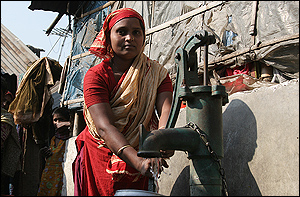 WaterAid | Juthika Howlander WaterAid | Bangladesh In Bangladesh only 74% of people have safe water and 39% have sanitation. WaterAid has worked in Bangladesh since 1986 and, with 16 partner organisations, helps to improve the lives of the poorest and most marginalised people through water, sanitation and hygiene education projects. The programme provides diverse technological solutions, including tackling saline intrusion into water sources in coastal regions and installing gravity flow schemes in hill areas. WaterAid and its partners also promote community-led total sanitation approaches, where communities build their own low-cost latrines and encourage others to do the same so everyone gains the maximum health and hygiene benefits. In urban areas, particularly the vast slums of Dhaka where around two million people are without water or adequate sanitation, we set up communal waterpoints and sanitation blocks. Find out more about WaterAid in Bangladesh.(c) WaterAid 2008 |
Más sobre WaterAid | Bangladesh
1: Living on shifting sands
 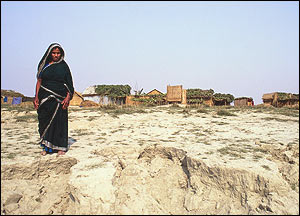 WaterAid | Abir Abdullah WaterAid | Living on shifting sands Providing water and sanitation in one of the most hazardous regions of Bangladesh. For communities living on scattered sandbanks, called chars, in the centre of the Jamuna River in Bangladesh, life is tough: dusty in the dry season, flooded and eroded when the monsoon rains come. Accessing clean water is a big challenge. On Erendabari Char, one of the larger, more stable, sandbanks, life has started to improve. WaterAid has been working with Unnayan Shahojogy Team enabling 1,000 people to gain access to safe water. Latrines are being constructed and hygiene education is underway. Find out more about WaterAid in Bangladesh.(c) WaterAid 2008 |
Más sobre Living on shifting sands
2: Can pay, will pay
 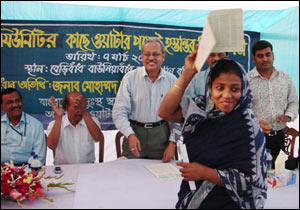 WaterAid | Kazi Shamsul Amin WaterAid | Can pay, will pay Slum dwellers in Dhaka prove they can and will pay for legal, safe, water. In the slums of Dhaka, Bangladesh, gaining legal access to water is a big political issue. In the eyes of the local authorities, slum dwellers live in "transient" settlements, despite the fact that many slums have existed for decades and therefore have no legal right to water. By acting as an intermediary, WaterAid and local partner Duhstha Swastha Kendra (DSK) have helped 185 families in Dhaka's Mirpur area win the right to a safe, legal water supply; a vast improvement to buying potentially unsafe water from illegal vendors. Finally, the prospect of long-term legal water supply to slum dwellers in Dhaka is becoming more realistic. Find out more about WaterAid in Bangladesh.(c) WaterAid 2008 |
Más sobre Can pay, will pay
3: Where does all the goo goo go?
 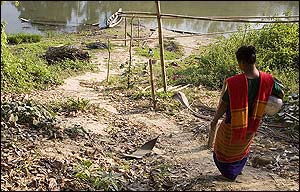 WaterAid | Juthika Howlader WaterAid | Where does all the goo goo go? In rural areas, you might think that it's ok to go to the toilet in the bushes. You'd be wrong...
It ends up in the ponds used for washing. Chickens walk it into people's houses. Flies carry it to food. People eat it. Disgusted with this knowledge, communities take action and build latrines. By empowering communities to take action WaterAid has helped more than a million people gain access to sanitation in the last year alone. Find out more about WaterAid in Bangladesh.(c) WaterAid 2008 |
Más sobre Where does all the goo goo go?
4: Spreading the message
 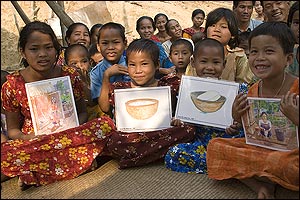 WaterAid | Juthika Howlader WaterAid | Spreading the message Hygiene education in the Chittagong Hill Tracts. WaterAid knows that clean water and safe sanitation do not, on their own, change lives. The vital piece of the jigsaw is hygiene education. The geographically dispersed Chittagong Hill Tracts area is home to 1.4 million people, made up of 11 ethnic communities. This can make hygiene education a real challenge. In Indramoni Para, WaterAid's partner Green Hill run hygiene sessions with the aid of picture cards. Girls like Kripa, 13, have learnt that "After going to the toilet you have to wash your hands with soap because your hands might be infected with germs and you can get ill." Find out more about WaterAid in Bangladesh.(c) WaterAid 2008 |
Más sobre Spreading the message
5: WaterAid | Burkina Faso
 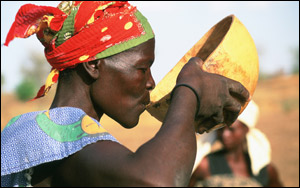 WaterAid | Suzanne Porter WaterAid | Burkina Faso In Burkina Faso 61% of people have safe water and only 13% have sanitation. WaterAid works with seven partners providing sustainable, low-cost water and sanitation services within the poorest and most vulnerable communities of Burkina Faso. Micro credit schemes are available to help individuals build latrines or to receive training in making and selling soap as part of a hygiene education and poverty reduction programme. We are now planning to support 27 local governments in localising the UN Millennium Development Goal targets, to halve the proportions of people living without water or sanitation by 2015, so they become more achievable in specific areas. WaterAid will also lobby nationally for greater investment in water and sanitation, and ensure that all projects consider the impact and sustainability of water supplies. Find out more about WaterAid in Burkina Faso.(c) WaterAid 2008 |
Más sobre WaterAid | Burkina Faso
6: Localising the Millennium Development Goals
 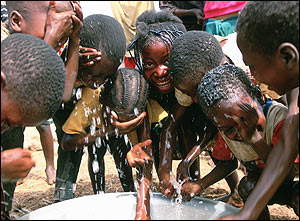 WaterAid | Suzanne Porter WaterAid | Localising the Millennium Development Goals Aiming to halve the proportion of people living without water or sanitation services by 2015. The Millennium Development goals, agreed by all governments, include targets to halve the proportions of people without access to safe water and sanitation. In areas where so few have access, achieving this can be a daunting task. But in Burkina Faso, WaterAid's new initiative of localising the targets is helping to focus work to reach those most in need. Communities have helped to identify a set of prioritised actions for water, sanitation and hygiene, which are now being used by the 302 newly created local governments in rural areas and the 49 in urban areas. Find out more about WaterAid in Burkina Faso.(c) WaterAid 2008 |
Más sobre Localising the Millennium Development Goals
7: Supplementing household supplies
 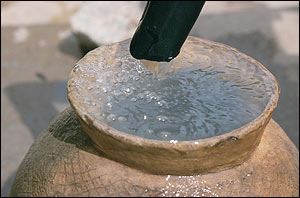 WaterAid | Suzanne Porter WaterAid | Supplementing household supplies Despite Ouagadougou receiving an average of 700mm rainfall per year Burkina Faso's climate, hydro-geological conditions and flat topography mean that water scarcity is an ongoing problem. Working with local partners and some of the country's poorest people, WaterAid has helped to build much-needed concrete tanks to collect rainwater in communities and schools. With a capacity of 10 cubic metres, water stored in these tanks can supply a household of six to eight people with drinking water for two months. Find out more about WaterAid in Burkina Faso.(c) WaterAid 2008 |
Más sobre Supplementing household supplies
8: Small dams
 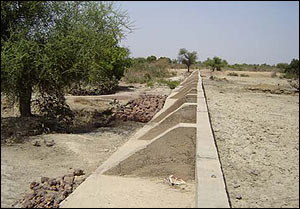 AMB Mahama Savadogo WaterAid | Small dams In Madyr, the village wells used to dry up in February. High run off during the rainy season meant that insufficient amounts of water percolated into local wells to meet demand. The community often had to walk miles to collect water from the nearest source. WaterAid has worked in partnership with AMB to construct a small dam. This helps to retain water which then seeps into village wells. The community can now collect water locally throughout the year. According to a member of the community, "The well water level has increased so much that we can now meet our domestic and livestock needs." Find out more about WaterAid in Burkina Faso.(c) WaterAid 2008 |
Más sobre Small dams
9: WaterAid | Ethiopia
 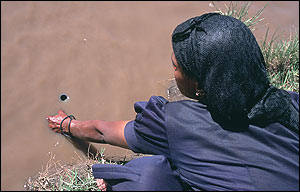 WaterAid | Caroline Irby WaterAid | Ethiopia In Ethiopia just 22% of people have safe water to drink and only 13% have sanitation. In Ethiopia, WaterAid works with eight main partners including NGOs and the local government. Ethiopia's water supply coverage is one of the lowest in the world and the country's varied terrain requires several different water solutions, from spring-fed gravity schemes in the mountainous regions to boreholes in the arable plateaus. WaterAid also strengthens partnerships and networks to help organisations work in a coordinated way to promote good hygiene and sanitation, vital where only 13% of the population have access to a toilet. WaterAid also aims to support communities in assessing the quality of water and sanitation provision in their area, encouraging them to demand more from local service providers. Find out more about WaterAid in Ethiopia.(c) WaterAid 2008 |
Más sobre WaterAid | Ethiopia
10: Gravity flow schemes
 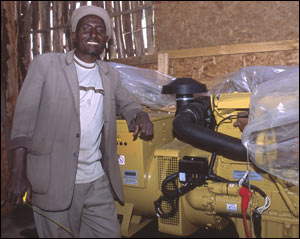 WaterAid | Carlos Reyez-Manzo WaterAid | Gravity flow schemes In mountainous areas, water supply coverage can be increased by using the power of gravity. Dogoma near Gonder in the rugged mountains of northern Ethiopia is typical of many villages in the area where natural water sources can only be reached by a long, arduous climb. WaterAid worked with villagers and a partner organisation to cap a spring, pump water to a huge reservoir tank and use a gravity-flow system to pipe water close to people's homes. This kind of scheme is common across the area, providing safe water for domestic and small scale agricultural use and helping people escape the drudgery of water-collection. Find out more about WaterAid in Ethiopia.(c) WaterAid 2008 |
Más sobre Gravity flow schemes
11: Reaching the hard to reach
 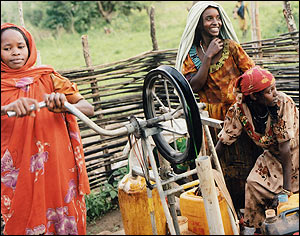 WaterAid | Kate Eshelby WaterAid | Reaching the hard to reach WaterAid began working in the remote area of Benishangul Gumuz in 2004. Benishangul Gumuz is home to some of the poorest communities in the world. In rural areas like this in Ethiopia just 11% of the population have safe water and fewer still, just 4%, have access to sanitation. WaterAid has introduced life-changing, sustainable and cheap technologies like composting latrines, where human waste is left to decompose into fertiliser; rope pumps, which are easily manufactured from local materials; and innovative techniques like child to child hygiene education, where children pass hygiene messages on to their friends and families. Find out more about WaterAid in Ethiopia.(c) WaterAid 2008 |
Más sobre Reaching the hard to reach
12: Flying toilets
 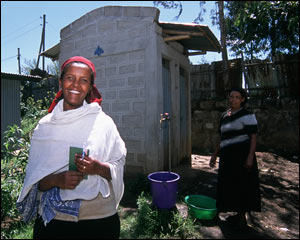 WaterAid | Caroline Irby WaterAid | Flying toilets In crowded, urban areas with no sanitation people can be forced to defecate in plastic bags and throw them to the side of the street. These 'flying toilets' make the neighbourhood into a dangerous mess and cause widespread diarrhoeal diseases. For women, a lack of latrines means a lack of privacy, often meaning they 'hold on' until nightfall to go, when they risk attack and abuse. In the slum areas of Addis Ababa, WaterAid and other organisations are coordinating to build latrines and safe water supplies. Agare, a female resident, says: "We never thought it was possible to have such a beautiful latrine with water for hand-washing. Now we feel human." Find out more about WaterAid in Ethiopia.(c) WaterAid 2008 |
Más sobre Flying toilets
13: WaterAid | Ghana
 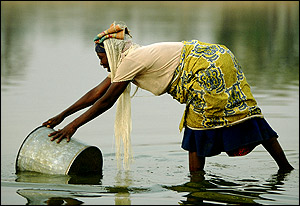 WaterAid | John Spaull WaterAid | Ghana In Ghana 75% of people have access to safe water and only 18% have sanitation. Since 1985, WaterAid has worked with eight partner organisations, which manage water, sanitation and hygiene education projects in six of Ghana's eight regions.Communities take responsibility for their projects, installing latrines, boreholes and hand-dug wells. WaterAid trains village health coordinators to pass on good hygiene messages and help prevent the spread of water-related diseases such as guinea worm, which is still prevalent in areas of northern Ghana.Local partners help the poorest and most marginalised communities to assess the water and sanitation services in their area, encouraging them to engage with local and national governments and demand action from those responsible for providing these services. Find out more about WaterAid in Ghana.(c) WaterAid 2008 |
Más sobre WaterAid | Ghana
14: Women's work?
 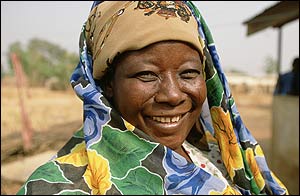 WaterAid | Jon Spaull WaterAid | Women's work? By highlighting the uneven distribution of tasks in communities, women's burdens are being reduced. In the Birim North District, like much of rural Ghana, women are responsible for cooking, cleaning, fetching water, bathing the children and farm work. WaterAid believes that women must be involved in the development process, but shouldn't be over-burdened. To try and avoid this, WaterAid helps communities identify work loads and looks at how men can share the burden of tasks traditionally seen as "women's work". This enables women to have time to take a key role in improving their lives. Find out more about WaterAid in Ghana.(c) WaterAid 2008 |
Más sobre Women's work?
15: Pregnancy without water
 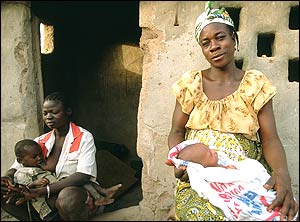 WaterAid | Jon Spaull WaterAid | Pregnancy without water Clean water and sanitation become even more important when you're pregnant. Aurigo village in Ghana's Upper East region lacks plentiful water, making it a particularly challenging place to be pregnant. When Ladi Cazone was pregnant she tried to collect water but often got dizzy and couldn't manage the walk with such a heavy load. Friends helped but sometimes she had to pay people to collect water for her. Now it is a struggle to find enough water to keep her new baby clean. WaterAid's partner Rural Aid is trying to help but faces challenges as groundwater resources are not present in any great amount in this area. Find out more about WaterAid in Ghana.(c) WaterAid 2008 |
Más sobre Pregnancy without water
16: Sewage in the slums
 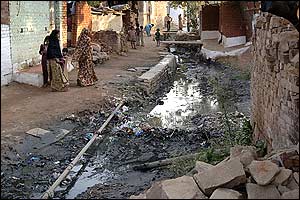 WaterAid | Marco Betti WaterAid | Sewage in the slums In Gwalior, 400,000 people, a quarter of the city's population, live in slums. Conditions are tough - with few safe water points and minimal sanitation, disease is widespread. The lack of sanitation facilities also means women wait for the privacy of nightfall to go to the toilet, risking sexual attack. WaterAid and its partner Sambav are helping communities to set up formal self-help groups and demand their rights, such as safe water and sanitation, from the local government. Together these women's groups gain confidence, establishing projects, sharing hygiene messages and helping other women set up their own groups. Find out more about WaterAid in India.(c) WaterAid 2008 |
Más sobre Sewage in the slums
17: Overcoming gender divides
  WaterAid | Marco Betti WaterAid | Overcoming gender divides Women are now training to be mechanics to keep their village handpumps working. In the villages near Mahoba, community members weren't trained to maintain or repair the government-installed handpumps. This meant that if they broke, they could take months to fix, forcing people back to open wells or on long walks to other pumps. WaterAid's partner Gramonati Sansthan have trained women to become mechanics to maintain their local pumps. Uma Devi explains, "By becoming mechanics we have broken the tradition and shown that women can also do this kind of work." Find out more about WaterAid in India.(c) WaterAid 2008 |
Más sobre Overcoming gender divides
18: Life saving loos
 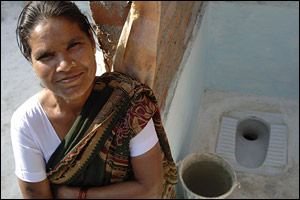 WaterAid | Marco Betti WaterAid | Life saving loos With only 33% of India's population having access to sanitation, 670 million people need a latrine. The lack of sanitation impacts upon all areas of people's lives - infant deaths, lost work days, expensive medicines and missed school all have an economic cost. There is compelling evidence that sanitation brings the greatest return on investment of any development intervention (roughly $9 for every $1 spent). WaterAid and its partners help communities build simple latrines, like Uma Devi's in Premnaga village (pictured), which, together with safe water and hygiene education, are vital for overcoming poverty. Find out more about WaterAid in India.(c) WaterAid 2008 |
Más sobre Life saving loos
19: WaterAid | India
 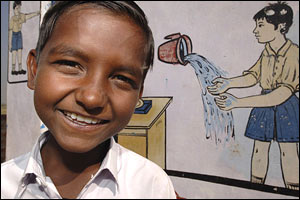 WaterAid | Marco Betti WaterAid | India 86% of people in India have safe water and only 33% have sanitation. Working in India since 1986, WaterAid and its 50 partner organisations now work in ten states across the country. Hygiene messages are promoted in rural areas through the mass-media and in schools. This also improves sanitation by creating a demand for latrines, vital in a country where 700 million people live without access to a toilet. In urban areas WaterAid mediates between people living in unplanned settlements and water authorities to negotiate connections to the city's water supplies, as well as helping communities to establish communal, self-managed waterpoints and sanitation blocks. By demonstrating cost effective, practical solutions and encouraging communities to establish their own water and sanitation self-help groups, WaterAid is able to influence policy decisions and has already successfully persuaded the Indian Government to change its sanitation subsidies to include low-cost latrines. Find out more about WaterAid in India.(c) WaterAid 2008 |
Más sobre WaterAid | India
20: Reaping the rewards
 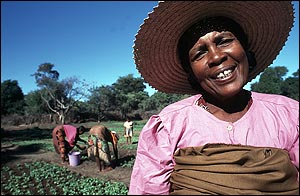 WaterAid | Jeremy Horner WaterAid | Reaping the rewards Safe water close to home can bring many benefits. One is the opportunity to grow crops which improve people's diet, health and income, as Ikognane from Mohairiry Kitchen Garden village explains: "Before the well we had no kitchen garden. There was not anything you could eat on this bit of land - there just wasn't enough rain to make things grow. Now we have a garden we are able to eat a much greater variety of vegetables than before. It is much healthier. We also sell some of our vegetables so make some money in that way." Find out more about WaterAid in Madagascar.(c) WaterAid 2008 |
Más sobre Reaping the rewards
21: Piping the supply
 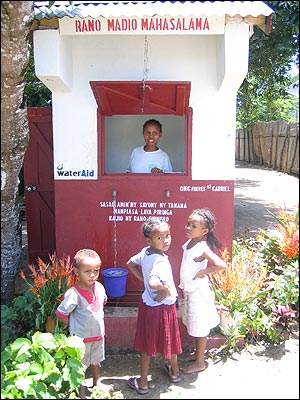 WaterAid | Lisa Martin WaterAid | Piping the supply In a situation echoed across the developing world, the poorest residents in Madagascan towns are the least likely to be connected to the mains water supply. Instead they pay a high price from street vendors or rely on unsafe sources for their water. WaterAid and its partners are helping to connect communities to the mains water supply by liaising with the water providers on their behalf. Water kiosks are established where residents can buy safe water at a reasonable price. Caretakers like Tsara Emeline (pictured in Ampasimpotsy Quatier) manage the kiosks and collect money to pay for the water supply, maintenance and their wages. Find out more about WaterAid in Madagascar.(c) WaterAid 2008 |
Más sobre Piping the supply
22: WaterAid | Madagascar
 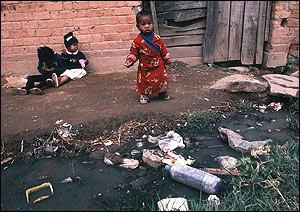 WaterAid | Jeremy Horner WaterAid | Madagascar In Madagascar 50% of the population has safe water and only 34% have sanitation. WaterAid supports six main partner organisations in three of Madagascar's six provinces. These implement low-cost sanitation services and promote good hygiene practices alongside providing water supplies through gravity fed schemes, well construction and locally manufactured rope pumps. As water and sanitation are vital for health, education and livelihoods, WaterAid uses its research to influence the Government to put water and sanitation at the heart of their poverty reduction plans. WaterAid aims to improve organisations' ability to meet the Millennium Development Goals of halving the proportion of people living without access to safe water and sanitation by 2015, develop its work in unplanned urban areas and continue to support the Government in implementing a coordinated sanitation policy. Find out more about WaterAid in Madagascar.(c) WaterAid 2008 |
Más sobre WaterAid | Madagascar
23: Mapping the way
 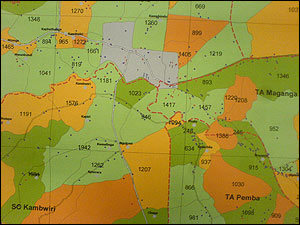 WaterAid | Vinny Casey WaterAid | Mapping the way In the past there was no data showing where water and sanitation facilities were located in Malawi, and so access to safe water was inequitable with some communities having many water points, while others had none. In response to the problem WaterAid initiated a water point mapping project to determine the location and functionality of water services in rural communities. The whole of the country has now been mapped and the research shows that only 57% of the population have access to safe water - considerably lower than the 73% quoted as the official figure. These maps can now be used to plan and coordinate future work to ensure it reaches those who need water the most. Find out more about WaterAid in Malawi.(c) WaterAid 2008 |
Más sobre Mapping the way
24: Impacts on health
 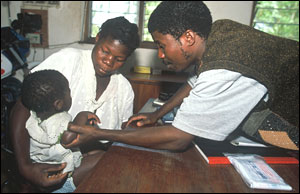 WaterAid | Jon Spaull WaterAid | Impacts on health Without a supply of safe water or a clean place to go to the toilet, communities are exposed to many diseases, as Mr Machangwa, who runs the Lifuwu clinic in the Salima district, explains. Dysentery is a frequent problem amongst the 10,000 people in our catchment. It costs us about 200 Kwacha (£2) to cure a patient and in every one of these cases dirty water and poor sanitation are to blame. WaterAid is helping communities here to set up safe water supplies, to build latrines and to learn about safe hygiene practices in an effort to combat these diseases. Find out more about WaterAid in Malawi.(c) WaterAid 2008 |
Más sobre Impacts on health
25: Bringing pumps back into action
 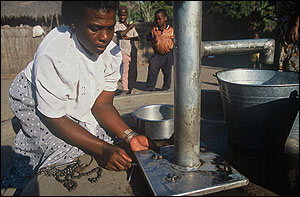 WaterAid | Jon Spaull WaterAid | Bringing pumps back into action In many areas of Malawi water pumps have fallen into disrepair as there is no one, and no spare parts available, to maintain them. As well as mapping the water points to see which are functioning, WaterAid is also looking to rehabilitate existing pumps, and ensure these, and any new pumps that are installed, can be maintained by the community who uses them. Zeinabu Kayisi (pictured) now maintains the water pump in Chiutila village. "Being able to maintain the pump myself makes me feel independent and strong!" she says. Find out more about WaterAid in Malawi.(c) WaterAid 2008 |
Más sobre Bringing pumps back into action
26: WaterAid | Malawi
 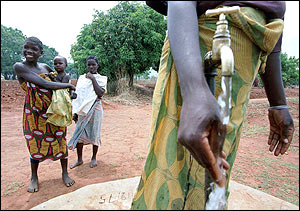 WaterAid | Alixandra Fenton WaterAid | Malawi 73% of people in Malawi have safe water and 61% have sanitation. In Malawi, WaterAid works in four rural areas and in the capital city Lilongwe with two district governments, four civil society organisations and a public water utility company. WaterAid and its partners have mapped all existing water facilities in the country. This has demonstrated the uneven distribution of water points and highlighted that only 68% are functioning. WaterAid now focuses on rehabilitating these broken systems. WaterAid also helps communities set up water and sanitation self-help groups, encourage the use of composting latrines, which produce manure that boosts crop yields, and run hygiene education activities. Since 2005 WaterAid has also worked with the Malawian Government and others to establish a national sanitation policy. Find out more about WaterAid in Malawi.(c) WaterAid 2008 |
Más sobre WaterAid | Malawi
27: Rehabilitation of traditional wells
 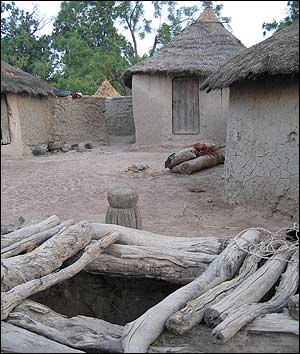 WaterAid | Therese Mahon WaterAid | Rehabilitation of traditional wells Open wells like the one pictured above can be hazardous to childeren and disabled people. In the areas around Bamako safe water is scarce; the water coverage barely reaches 30%. Many local people use traditional wells as a source of drinking water but these are often dangerous to use and, because they are not protected, open to contamination and pollution. WaterAid and its partners are helping communities in suburban settlements around Bamako to rehabilitate their traditional wells. Cheap, local materials are being used so that communities can maintain these rehabilitated water supplies in the future. Find out more about WaterAid in Mali.(c) WaterAid 2008 |
Más sobre Rehabilitation of traditional wells
28: WaterAid | Mali
 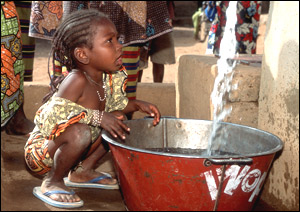 WaterAid | Daniel O'Leary WaterAid | Mali In Mali only half of the population have safe water and 46% of people have sanitation. WaterAid works in five of Mali's eight regions and in the capital Bamako with seven partner organisations helping to provide community tapstands, hand-dug wells and latrines to marginalised people. Women in particular are empowered through soap-making and micro credit schemes. WaterAid has mapped the existing water and sanitation services in all 703 local government areas, allowing the areas most in need to be prioritised. WaterAid also focuses on poor water supply and sanitation in slum areas and lobbies for increased funding for water and sanitation. Find out more about WaterAid in Mali.(c) WaterAid 2008 |
Más sobre WaterAid | Mali
29: X marks the spot
  WaterAid | Google Earth WaterAid | X marks the spot Water point mapping ensures water supplies are built where they are needed most. In Mozambique, as in many countries where WaterAid works, there is limited data showing where water points are, or if they are working. This hinders efforts to reach the people who need water the most. WaterAid is helping communities to map existing water and sanitation facilities in their local area so that the new water points can be decided on in a fair, equitable way. Functioning and non-functioning water points are mapped so that water points can be rehabilitated, if necessary, or new water points can be installed in areas where they are most needed. Find out more about WaterAid in Mozambique.(c) WaterAid 2008 |
Más sobre X marks the spot
30: Roping in the community
 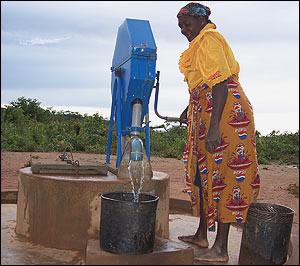 WaterAid | Therese Mahon WaterAid | Roping in the community Using locally sourced, cheap materials, the rope pump in Mozambique provides water and work. The lack of infrastructure, spare parts and cash economy all contribute to the problems of maintaining water pumps in rural areas. If they break and can't be fixed communities are forced back to dirty water sources. Piloted in 1993, the rope pump provides a simple solution. Made cheaply from locally available materials such as tyres and rope they supply safe, clean water and can be easily mended if they break. From my experience, says local contractor Mr Chitime, "communities readily accept the rope pump. They can see it is simple." Find out more about WaterAid in Mozambique.(c) WaterAid 2008 |
Más sobre Roping in the community
31: WaterAid | Mozambique
 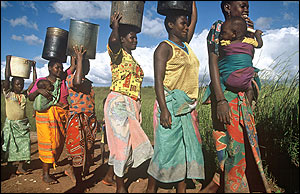 WaterAid | John Spaull WaterAid | Mozambique In Mozambique only 43% of the population has safe water and 32% have sanitation. WaterAid has projects in two of the poorest and most remote regions of Mozambique: Niassa and Zambezia. In these rural areas WaterAid and its partners promote simple rope pumps, which are cheaply and easily maintained, and composting latrines. In Niassa villages are being helped to become free from open defecation and since 2003, WaterAid has also worked towards achieving 100% water and sanitation coverage in five slum settlements of the capital Maputo and aims to extend this work to Quelimane in the future. To ensure sustainability, low-cost technologies will continue to be developed and promoted, boreholes will be tested for bacteria and water quality tests will be carried out every three years. Find out more about WaterAid in Mozambique.(c) WaterAid 2008 |
Más sobre WaterAid | Mozambique
32: Blue gold
 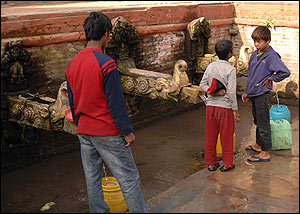 WaterAid | Marco Betti WaterAid | Blue gold Repairing Kathmandu's cultural heritage and city water source. Ornate, serpent-headed waterpoints are a unique part of Kathmandu's ancient heritage. They also provide free water for all, enabling even the poorest to access a regular supply. But in recent years the water points have been falling into disrepair and the water quality became dubious. Together with partners and community groups WaterAid has been rehabilitating traditional water sources to ensure they provide safe, clean water while also maintaining the city's cultural heritage. Find out more about WaterAid in Nepal.(c) WaterAid 2008 |
Más sobre Blue gold
33: Using reeds to treat wastewater
 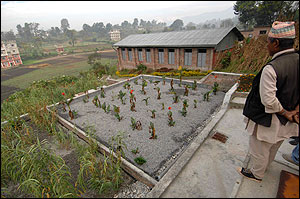 WaterAid | Marco Betti WaterAid | Using reeds to treat wastewater Without sewerage, waste water from communities pollutes open areas and water sources. At Sunga in Thimmee, WaterAid's partner ENPHO are trialling reed beds to treat wastewater. Following its success other schemes are being planned across Kathmandu. After four days in sedimentation tanks, wastewater from 110 households flows into the reed beds where it is naturally filtered and cleaned. The resulting water is then stored, and will be diverted to a neighbouring school to be used in their toilet block. The sludge in the sedimentation tanks is left to decompose before being used by farmers as fertiliser. Find out more about WaterAid in Nepal.(c) WaterAid 2008 |
Más sobre Using reeds to treat wastewater
34: WaterAid | Nepal
 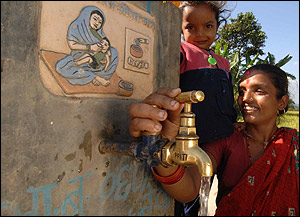 WaterAid | Marco Betti WaterAid | Nepal In Nepal 90% of people have access to safe water but only 35% have access to sanitation. WaterAid began work in Nepal in 1986 and promotes appropriate, low-cost and sustainable technologies across the country, from traditional wells and tubewells in the flat, fertile Terai to gravity-flow piped supplies in the steep foothills and mountains of the Himalayas. We are helping communities demand water and sanitation from service providers and our work in influencing policies means that around 175,000 people in the Kathmandu valley will benefit from a significant reduction in the water connection charge. WaterAid is expanding its urban projects to meet the rapidly increasing need for water and sanitation in towns and cities and we will continue to lobby for more and better financing, with special emphasis on sanitation. Find out more about WaterAid in Nepal.(c) WaterAid 2008 |
Más sobre WaterAid | Nepal
35: WaterAid | Nigeria
 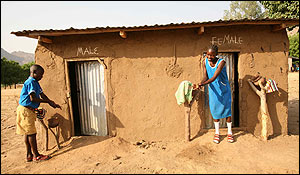 WaterAid | Suzanne Porter WaterAid | Nigeria In Nigeria only 48% of people have safe water and 44% have sanitation. WaterAid works in six states in Nigeria, increasing local governments' ability to provide water and sanitation and to be accountable to their communities. To advise on the nature and scale of work needed WaterAid has carried out a detailed national assessment of water and sanitation issues. Mapping and rehabilitating existing facilities will mean new projects are implemented where they are most needed. Households direct project work themselves, determining their own levels of poverty against criteria suggested by their community. Local businesses are contracted to drill boreholes, install pumps and run 'sani-centres' selling materials for latrine construction. WaterAid will continue to improve water resource management through the promotion of sustainable technologies such as rainwater harvesting. Find out more about WaterAid in Nigeria.(c) WaterAid 2008 |
Más sobre WaterAid | Nigeria
36: Keeping the pumps flowing
 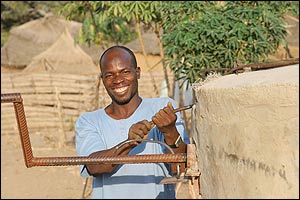 WaterAid | Suzanne Porter WaterAid | Keeping the pumps flowing Locally trained mechanics are making sure that a safe water supply is maintained. WaterAid's partners train local women and men like Haruna Abdullah, from Birnin Gaye, Bauchi State, to be able to maintain and repair water points in their village. This means that supplies are safe and sustainable, and that people don't have to revert to using dangerous water sources, contaminated with disease. A recent WaterAid survey of Ekiti State showed that 100% of all handpumps were working well thanks to the efforts and expertise of local people. Find out more about WaterAid in Nigeria.(c) WaterAid 2008 |
Más sobre Keeping the pumps flowing
37: Mapping waste
 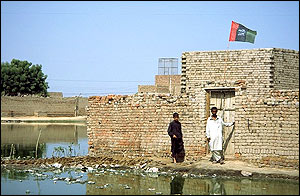 WaterAid | Martin Punaks WaterAid | Mapping waste In Faisalabad, accurate mapping is helping to identify and improve the city's sanitation needs. It has been difficult to target sanitation interventions in the city of Faisalabad because there have been no accurate maps available. When WaterAid supported a community in the Shamsabad area to begin a programme of self reliance and build their own facilities, the community started by lobbying local government to draft accurate maps of the area. With the help of accurate sanitation mapping the community can identify where to lay pipes to take the dangerous waste, that currently collects in the neighbourhood, to the nearest municipal sewer. Find out more about WaterAid in Pakistan.(c) WaterAid 2008 |
Más sobre Mapping waste
38: Officiating for the unofficial
 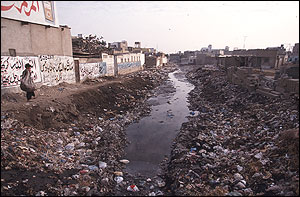 WaterAid | Caroline Penn WaterAid | Officiating for the unofficial WaterAid is supporting work to facilitate dialogue between government and 'unofficial' slum communities who are undertaking large scale sanitation projects themselves. The sprawling, unplanned slums that surround the large cities in Pakistan do not qualify for government aid to build sewage systems due to their unofficial status. In 1996, WaterAid started supporting the Orangi Pilot Project (OPP) in constructing and improving sewers in the slums of Karachi. The OPP is a remarkable self-funded, self-administered and self-maintained grassroots movement whose urban poor constituents build hundreds of kilometres of extremely low cost underground sewers using local materials and labour. The role of OPP is to facilitate dialogue between the city authorities and the communities themselves as well as to provide training and technical guidance. Find out more about WaterAid in Pakistan.(c) WaterAid 2008 |
Más sobre Officiating for the unofficial
39: WaterAid | Pakistan
 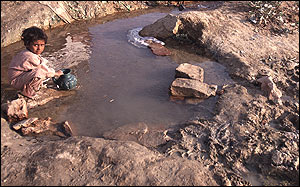 WaterAid | Caroline Penn WaterAid | Pakistan In Pakistan 91% of people have access to safe water and only 59% have access to sanitation. Since 1996, WaterAid and its partners have focused on the unplanned slum areas surrounding Pakistan's major urban centres. WaterAid supports the pioneering Orangi Pilot Project (OPP), a self-funded, administered and maintained grassroots movement, working with poor communities to construct and improve sewers in Karachi. WaterAid also supporters other organisations undertaking urban sanitation projects based on the OPP model. WaterAid opened a country office in 2006 and plans to extend work into rural areas, develop its strategy and play a leading role in influencing policy decisions. As Pakistan is one of the world's most water-stressed countries, WaterAid also plans to set up specific water projects in addition to continuing its sanitation work. Find out more about WaterAid in Pakistan.(c) WaterAid 2008 |
Más sobre WaterAid | Pakistan
40: WaterAid | Papua New Guinea
 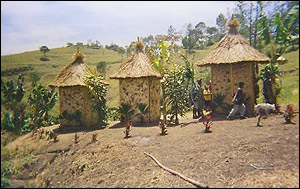 WaterAid Australia WaterAid | Papua New Guinea In Papua New Guinea only 44% of people have access to safe water and 39% of people have sanitation. Papua New Guinea is one of WaterAid's newest country programmes. Funds from WaterAid Australia allowed work to begin in 2005 and we have successfully completed our first project, building latrines and introducing hygiene education programmes in schools in the Eastern Highlands. In partnership with Oxfam New Zealand and ATProjects, WaterAid aims to continue this work while developing a five year strategy and identifying new partners and projects. WaterAid will continue to focus on providing rural communities with essential water and sanitation facilities and hopes to work with the Government as they prioritise water quality monitoring, safe waste disposal and sustainable water supplies during droughts as part of their 2001-2010 National Health Plan. Find out more about WaterAid in Papua New Guinea.(c) WaterAid 2008 |
Más sobre WaterAid | Papua New Guinea
41: WaterAid | Tanzania
 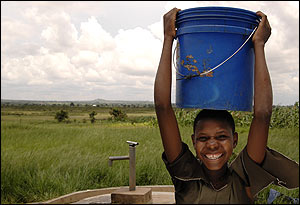 WaterAid | Marco Betti WaterAid | Tanzania In Tanzania 62% of the population have safe water and only 47% have sanitation. In Tanzania, WaterAid works in five rural districts and in Dar es Salaam. Technology approaches include rehabilitating boreholes, constructing shallow wells, pit latrines and disposal pits. WaterAid also educates communities about sanitation and good hygiene, encouraging practices such as handwashing. Children learn these messages in school health clubs and then share them with friends and family. WaterAid aims to continue to map both functioning and non-functioning waterpoints in rural and urban areas to identify where its work can be most effective. We also campaign for better regulations and more equitable distribution of waterpoints, using our mapping work to influence donor and government funding in order to ensure the least served areas are reached. Find out more about WaterAid in Tanzania.(c) WaterAid 2008 |
Más sobre WaterAid | Tanzania
42: Community pump house
 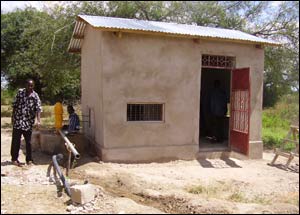 WaterAid | Marco Betti WaterAid | Community pump house In Bankholo, access to safe, clean water has started to transform village life. In Bankholo village, central Tanzania, villagers were often ill or at risk from deadly diseases because the only water they had to drink was dirty and unsafe. A borehole was drilled in the village in 1972, but when the diesel pump broke down the village lacked the funds or skills to repair it. Since then, the community has spent much of their time queuing to collect unsafe water from a dangerous traditional well that makes them sick. WaterAid has supported the community to build a pump house and install a pump and engine. Three 20,000 litre storage tanks have been constructed, with distribution pipes laid to taps around the village. Two pump attendants have also been trained to ensure the water continues to flow long into the future. Find out more about WaterAid in Tanzania.(c) WaterAid 2008 |
Más sobre Community pump house
43: Handpump theft
 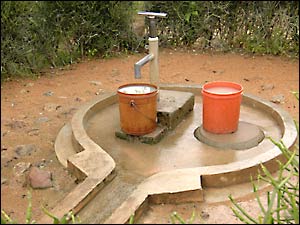 WaterAid | Marco Betti WaterAid | Handpump theft Communities in Tanzania who have had their handpump stolen face huge set backs. Water points are precious and can be liable to theft. So when WaterAid supported local partner SEMA to construct eight wells in Kisaki Village, measures were taken to ensure the community's new water points did not fall pray to vandalism or theft. Now, at the source where people used to collect water from a hazardous open well that was vulnerable to contamination, there is a WaterAid-funded improved well fitted with a NIRA handpump. The pump base is protected with concrete to prevent people from unscrewing the handpump and a watchman is appointed to look after the water point at night. Find out more about WaterAid in Tanzania.(c) WaterAid 2008 |
Más sobre Handpump theft
44: Radio soap promotes health
 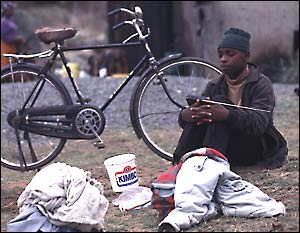 WaterAid | Caroline Penn WaterAid | Radio soap promotes health Tanzanian radio soap Pilika Pilika is helping WaterAid to reach the country's poorest people. Over 30 million people live in the East African country of Tanzania, and reaching them with messages about water, sanitation and hygiene can be problematic. By supporting Pilika Pilika, a radio soap modelled on the BBC radio show, The Archers, which transmits in Kiswahili, WaterAid is able to spread messages on hygiene, sanitation and water management across the country and reach some of the most distant communities. The soap is followed by a discussion programme that explores in detail some of the issues raised in the show through the views of rural communities, children, farmers and a panel of experts. Find out more about WaterAid in Tanzania.(c) WaterAid 2008 |
Más sobre Radio soap promotes health
45: Streets paved with sewage
 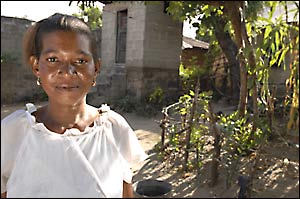 WaterAid | Marco Betti WaterAid | Streets paved with sewage Where there is no sewage disposal system in urban slums, composting latrines can help. In Mbuyuni part of the peri-urban Temeke District of Dar es Salaam, the lanes flow with raw sewage. A lot of households in Mbuyuni have pit latrines, but because there is no system in place to safely dispose of the hazardous waste in the pits, they are often emptied into the street during the rainy season. WaterAid and HERO promote composting latrines as a way around this problem. Composting latrines produce a dry compost which can be dug out and used for crops or sold once the latrines are full. Find out more about WaterAid in Tanzania.(c) WaterAid 2008 |
Más sobre Streets paved with sewage
46: Children lead the way
 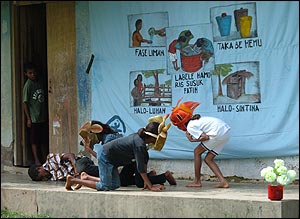 WaterAid | Peter Dwan WaterAid | Children lead the way Good hygiene is crucial for health. But, while adults sometimes find it hard to change behaviour they've used all their life, children are more receptive to taking on board new ideas. From puppet shows to picture cards, games and plays (like the one above in Aileu), WaterAid uses a range of methods to help children to learn about good hygiene. By encouraging them to pass on the lessons they learn to family and friends, children take on a vital role as hygiene ambassadors in WaterAid's programmes. Find out more about WaterAid in Timor-Leste.(c) WaterAid 2008 |
Más sobre Children lead the way
47: WaterAid | Timor-Leste
 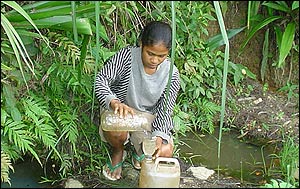 WaterAid Australia WaterAid | Timor-Leste 58% of people in Timor-Leste have safe water and only 36% have sanitation. In 2005 WaterAid began work in the new state of Timor-Leste, which has less than one million inhabitants. Here we aim to deliver sustainable, community managed water and sanitation services to rural communities in Aileu District through gravity-fed water systems and pour flush latrines. We also provide health and hygiene education there and in Baucau, Manatuto and Lautem Districts. Following its 25 year struggle for independence with Indonesia, the Government has been re-building the country's water and sanitation infrastructure. WaterAid is currently identifying needs, potential future partners and projects to enable this vital work to continue. Find out more about WaterAid in Timor-Leste.(c) WaterAid 2008 |
Más sobre WaterAid | Timor-Leste
48: Composting latrines
 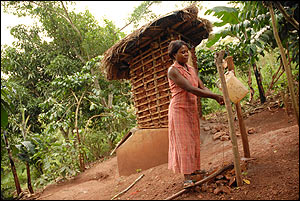 WaterAid | Caroline Irby WaterAid | Composting latrines Pit latrines may not be suitable for areas where the ground is hard or the water table is high. The soil around Kitayita village in central Uganda is hard and rocky. It can be very difficult for residents to dig latrine pits deep enough to safely dispose of their waste. When the rains come, these pits overflow and contaminate the area and water sources around them. WaterAid and its partner train local masons in the construction of composting latrines. These latrines are constructed and sealed so they can't contaminate the water table. Faeces is broken down into a harmless compost in dry, hot conditions inside the latrine and urine is diverted to a separate container where it can be used as a fertiliser for local crops. Find out more about WaterAid in Uganda.(c) WaterAid 2008 |
Más sobre Composting latrines
49: Rainwater harvesting
 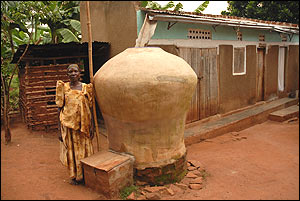 WaterAid | Caroline Irby WaterAid | Rainwater harvesting In areas where groundwater sources are seasonal or difficult to access, rainwater harvesting can be an effective way to augment drinking water supplies. The terrain around Kitayita village in central Uganda is steep and rocky. The community here have been hit hard by HIV/AIDS and there are many widows and single occupancy households. It can be difficult for the old and infirmed to collect water from local sources as it often involves climbing steep, slippery pathways. WaterAid helped to train local masons to construct large rainwater collection jars from locally available cement, plaster and bricks, enabling community members to have a safe source of water on their doorstep. Find out more about WaterAid in Uganda.(c) WaterAid 2008 |
Más sobre Rainwater harvesting
50: Finding alternative sources
 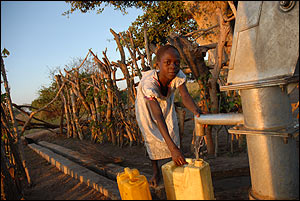 WaterAid | Caroline Irby WaterAid | Finding alternative sources Residents of Asine village used to collect drinking water from Lake Basina, where the water posed a serious health risk. The water is saline, with a high fluoride content which can cause defects in bones and teeth. Bilharzia larvae, which live in the lake's stagnant shores, burrow through people's skin damaging their pelvic organs, the lungs and nervous system. To overcome this problem, WaterAid's partner WEDA sunk a borehole and the community now benefits from a clean water supply. Diseases have dramatically reduced and women no longer need to spend hours walking three kilometres to the lake to fetch contaminated water. Find out more about WaterAid in Uganda.(c) WaterAid 2008 |
Más sobre Finding alternative sources
51: WaterAid | Uganda
  WaterAid | Caroline Irby WaterAid | Uganda In Uganda 60% of people have safe water and only 43% have sanitation. WaterAid works with seven partner organisations in five districts of Uganda, helping poor communities set up and manage their own low-cost, sustainable water, sanitation and hygiene education projects. Technologies include hand-dug wells, rainwater harvesting, composting latrines and traditional pit latrines. In the Mpigi district, a water resource guide called Atlas has helped to map the distribution of waterpoints. This information will be vital in allowing local governments to prioritise those areas which are most in need. WaterAid is also building the capacity of the decentralised district governments to manage funding effectively and also support the Uganda Water and Sanitation Network, which enables NGOs to share knowledge and coordinate activities. Find out more about WaterAid in Uganda.(c) WaterAid 2008 |
Más sobre WaterAid | Uganda
52: WaterAid | Zambia
 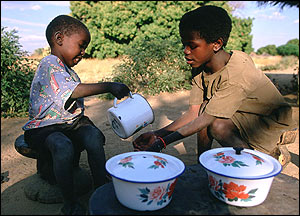 WaterAid | John Spaull WaterAid | Zambia Only 58% of people in Zambia have safe water and 55% have sanitation. A reduction in rainfall over the last 30 years has led to falling water tables and impacted on farming and nutrition in Zambia. Poverty is increasing and health is deteriorating. Active in Zambia since 1994, WaterAid works in four districts to support a range of partners including local authorities, NGOs and small scale private contractors. WaterAid has adopted the 'focus area' approach, supporting a large number of villages in one area, and will continue to supply those in the greatest need with low-cost, sustainable technologies such as hand-dug wells, boreholes, rope pumps and composting latrines. WaterAid also works at the national level with other water and sanitation organisations to influence their development agenda. Find out more about WaterAid in Zambia.(c) WaterAid 2008 |
Más sobre WaterAid | Zambia
53: Digging the future
 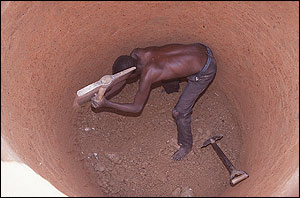 WaterAid | Jim Holmes WaterAid | Digging the future People pull together to provide time, labour and resources to improve the health of the community. With WaterAid's help, people can overcome their community's problem of unsafe water sources. In Tambala, in Monze, a safe water source was needed because scores of children in the village were getting sick with bilharzia from worms that penetrated their skin while collecting water from a local, contaminated stream. Robby Machindu [above] was one of the team who helped build a better future for the children of Tambala: "The problems with getting water for the community inspired me to volunteer to be part of the digging team," he said. Find out more about WaterAid in Zambia.(c) WaterAid 2008 |
Más sobre Digging the future
54: Bringing water to the scorched earth
 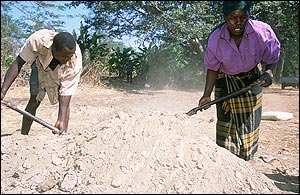 WaterAid | Jim Holmes WaterAid | Bringing water to the scorched earth Cut and burn' farming practices are stripping the landscape of trees and shrubs, making the soil even more parched. In the Southern and Western Provinces, the lack of vegetation means that any rain that falls simply flows away. The water table has dropped making droughts ever more frequent. To ensure the sustainability of water supplies WaterAid uses technologies which are appropriate to the local conditions. In Choobana village in Monze district (pictured) local people are rehabilitating a well, but in areas where water tables are very low, deeper boreholes and rainwater harvesting schemes have been trialed successfully. Find out more about WaterAid in Zambia.(c) WaterAid 2008 |
Más sobre Bringing water to the scorched earth